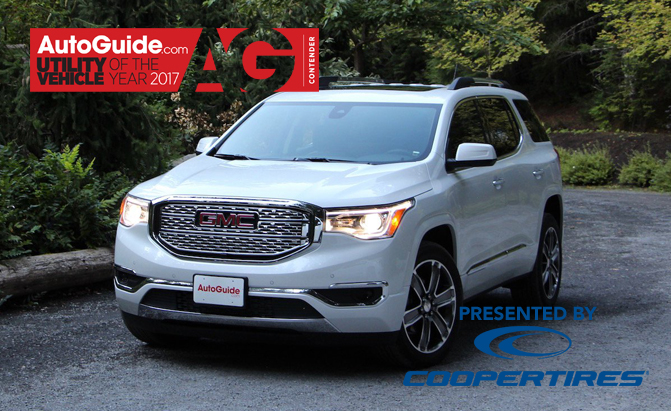AutoAfterWorld.com gathered five of the most significant utility vehicles for the 2017 model year for our annual Utility Vehicle of the Year evaluations. This year, our contenders are the Kia Sportage, Jaguar F-Pace, GMC Acadia, Audi Q7 and Honda CR-V. There was no hard price cap on this year’s entrants, but we tried to make sure none of them were extravagantly priced. We will release a new video on each contender every day leading up to April 13, when we announce our winner. In the meantime, don’t forget to check out our Car of the Year and Truck of the Year series.
Of all the new crossovers to hit the market in the last year, none has undergone more drastic changes than the 2017 GMC Acadia.
Like its fraternal twins, the Buick Enclave and Chevrolet Traverse, the Acadia was always a bit of a bloated and awkward entry in the market, offering a similar amount of space to the GMC Yukon without the sheer utility. However, all that changes for 2017, with the Acadia downsized significantly to slot neatly into the midsize segment.
Outside of its name, this new Acadia proffers very little that ties it to its predecessor. More than seven inches (178 millimeters) was chopped from its overall length and wheelbase, while almost four inches (102 mm) was removed from its width and height. The result is a right-sized offering that now registers as one of the smaller entries in the segment. Measuring 193.6 (4,917 mm) from tip to tail, the Acadia certainly isn’t small but it’s noticeably smaller than competitors like the Ford Explorer. The biggest return on the Acadia’s downsizing investment is at the scales, with roughly 700 lb (318 kg) cut from its curb weight.
Get the Flash Player to see this player.
The smaller size of the second-gen Acadia allowed for the introduction of a new four-cylinder base engine. A naturally aspirated unit, the 2.5-liter is good for 193 horsepower to go along with 188 lb-ft of torque. Neither measure will knock anyone’s socks off, but the engine delivers enough punch when called upon. It’s also the more efficient of the two engine options, with all-wheel drive versions rated at 21 mpg (11.2 L/100 km) around town and 25 mpg (9.4 L/100 km) on the highway.
ALSO SEE: 2018 Chevrolet Equinox Review
For those in need of additional output, the Acadia returns with an available 3.6-liter V6 in its second generation. The engine serves up a generous 310 horsepower to go along with 271 lb-ft of torque, which is plenty — especially for those looking to strap a trailer to the back. On that front, the Acadia is rated to tow 4,000 lb (1,814 kg) with the larger of the two engines under the hood, which is less than the 5,000 lb (2,268 kg) V6-powered Explorers are rated to tow but it’s still respectable. When it comes to fuel economy, the V6 version of the Acadia nets ratings of 18 mpg (13.3 L/100 km) in the city and 25 mpg (9.5 L/100 km) on the highway.
While front-wheel drive is standard on virtually all trim levels, it’s likely most new Acadias will put power to all four of them. And this new version of the Acadia offers two ways to do so. While a run-of-the-mill all-wheel-drive system is standard fare and features a disconnect feature to maximize fuel efficiency, the available All Terrain package adds a twin-clutch setup that features proper torque-vectoring capability. Featured on our tester, the system splits torque to each of the rear wheels independently, allowing better variability in torque distribution during low-traction situations.
The entire drivetrain system is a decent one and will feel familiar to anyone who has driven a GM crossover or SUV in recent years. Throttle response is smooth and sharp with the V6 generating power, while the suspension and steering setups are smooth and supple. Adaptive dampers are available on Acadia Denali models for increased road comfort, though they’re not exactly necessary.
Step inside and the Acadia can be served up six ways to Sunday ranging from affordable to overpriced. Base versions with the four-cylinder engine sending power to the front wheels start at $29,070 ($35,095 in Canada), while the top-of-the-line Denali starts at $45,070 ($54,895 in Canada) and ranges upwards in a hurry. Adding options like the Technology Package, which includes adaptive cruise control, can quickly push the price above $50,000 ($58,000 in Canada), which is enough to cover the cost of a Cadillac XT5.
ALSO SEE: 2017 Cadillac XT5 Premium Luxury Review
Regardless of which end of the wide price spectrum it falls, the Acadia’s interior features a fresh and modern layout and comes fairly well equipped. Apple CarPlay and Android Auto are standard, as is a built-in 4G LTE Wi-Fi hotspot to stay connected on the go. The cabin is also quiet and comfortable and leaves little to be desired.
Despite its smaller size, the 2017 GMC Acadia is still available with three rows of seating — though that doesn’t mean anyone old enough to drive would necessarily want to occupy all three of them. Likewise, cargo room behind third row is almost not worth mentioning, with a paltry 12.8 cu-ft (362 liters) on offer. That number does grow to a respectable 41.7 cu-ft (1,181 liters) with those seats folded, and 79 cu-ft (2,237 liters) with both rear rows out of the way.
From oversized to right-sized, the Acadia has shrunk significantly in its second generation to cater to the hugely popular midsize crossover segment. It’s a touch small compared to most of its competitors, but the Acadia makes the most of its dimensions to offer enough space, comfort and convenience to fit family life just fine.



Leave a Reply